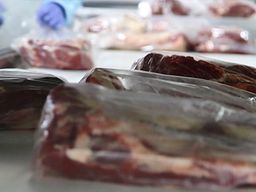Vacuum packed meat:
what you need to know
Characteristics, advantages and benefits of the meat when it is preserved by this method.
Vacuum packaging consists of extracting oxygen from the container where the product is, thus avoiding oxidation and putrefaction of the meat and prolonging its shelf life. An oxygen-free atmosphere retards the action of bacteria and fungi, making it possible to eat the product after a longer storage period. The process is free from additives an chemical preservatives.
The shelf life of meat is up to 120 days, maintained at an average temperature ranging from 0 ° C to + 5 ° C. Once this period is exceeded, vacuum-packed meat can be frozen at -5 °.
Advantages of vacuum packaging:
- It prevents oxidation caused by oxygen, and therefore putrefaction is null.
- Stabilizes the flavor and freshness of the meat, since there are no losses due to loss of liquids or fats.
- Allows large volume purchases and then to rationalize them in smaller portions.
- Creates a protection system against cuts in the cold chain.
By preserving food under vacuum, the chemical properties and the color, aroma and flavor qualities are not altered except for the meat, whose color is altered when packaging it in this way. When the meat is vacuum it turns purple due to lack of oxygen. When opening the package and airing the meat, it returns to its original bright red color. It is important that before preparing a vacuum-packed meat, it is left to rest open for half an hour so that, in contact with oxygen, it recovers its characteristic color.
Vacuum packed meat does not lose its quality in tenderness; on the contrary, when stored in chambers for several days under vacuum and at temperatures between 0 and 1 ºC (in a refrigerator, not a freezer), it becomes more tender due to the action of the meat's own enzymes.
Why the vacuum packaging in origin
Vacuum-packed meat is stripped in rooms of high quality standards, with adequate refrigeration conditions, guaranteeing hygiene, which can hardly be afforded by a traditional small retail establishment.
Throughout the process of stripping, packaging, storage and transfer, the meat is always kept refrigerated, optimizing its quality and subsequent preservation. This ensures that the meat is not subjected to constant temperature changes during its commercialization.
How to handle meat at home
If you have frozen the meat and want to cook it, defrost it slowly in advance, ideally in the refrigerator or at room temperature.
Never defrost meat in the microwave, with hot water or directly on the fire, as it will irretrievably lose its original quality of tenderness, juiciness




© Derechos de autor. Todos los derechos reservados.

